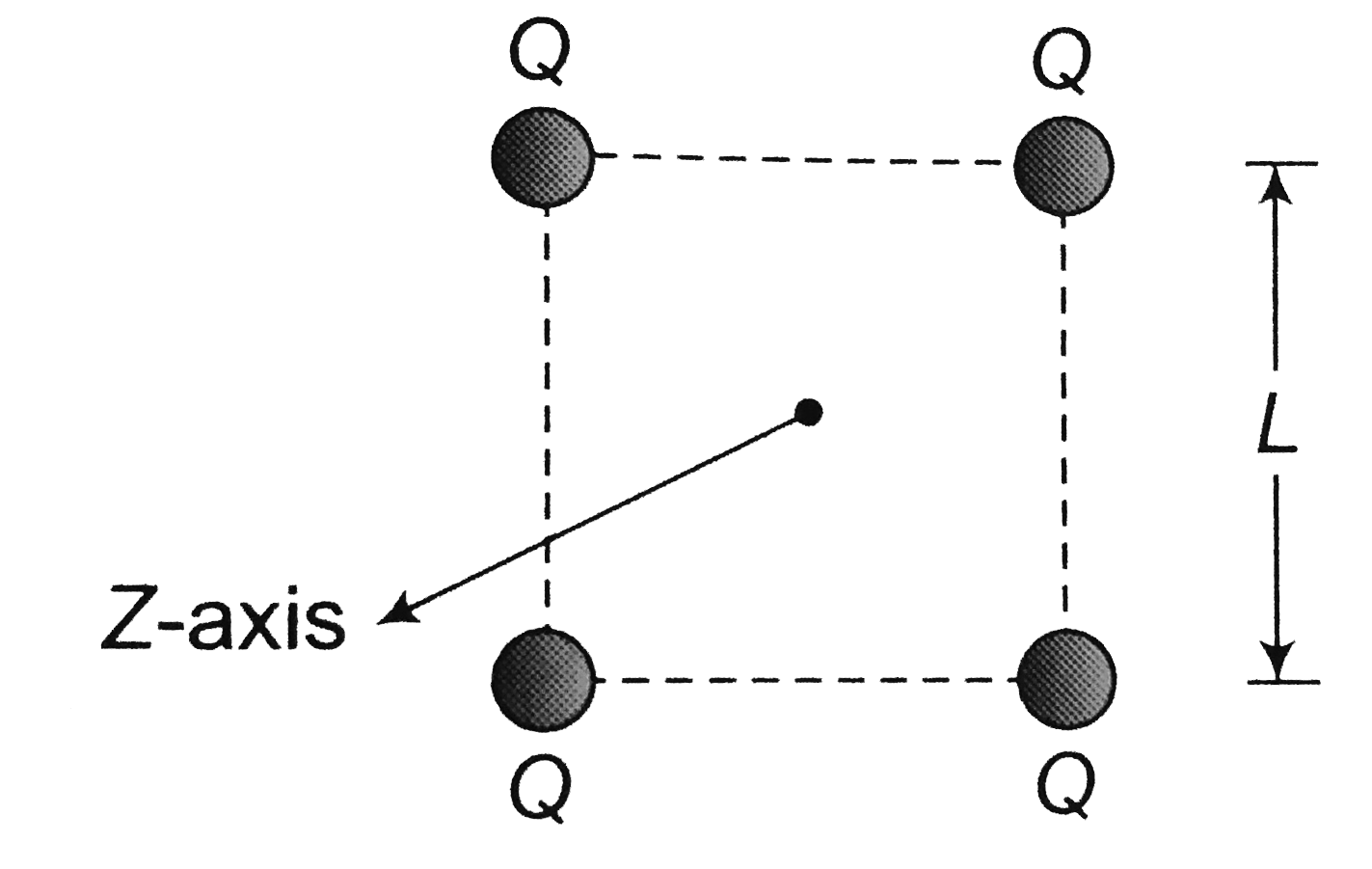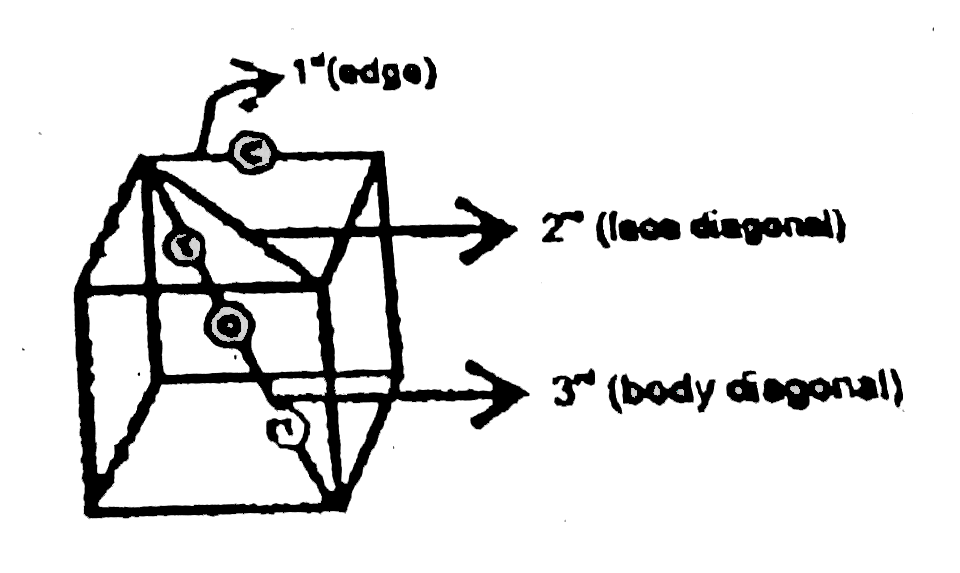Three lines are drawn from a single corner of an FCC unit cell to meet the other corner such that they are found to pass through exactly-1-Octahedral void only , no voids Octahedral void only .Identify the line in the same order -
Edge, Face diagonal , Body diagonal
Face diagonal , Edge , Body diagonal
Body diagonal , Face diagonal , Edge
Edge , Body diagonal , Face diagonal
The correct Answer is:A
Topper's Solved these Questions
Similar Questions
What is the number and closest distance between two octahedral voids and two tetrahdral voids in fcc unit cell ?
View SolutionA compound crystallises as follows :
ions ''A'' are at corners of a cubic unit cell and ''B'' ions at face centres of a cubic unit cell and ''C'' ions in 1/4th of the total tetrahedral void. Assuming if this is dissolved, only the ions in the tetrahedral voids are dissociated completely in water, which one of the following statements is true. (Assuming all are univalent ions) and also A and C are cations and B is an anions.View SolutionIn HCP or CCP constituent particles occupy 74% of the available space. The remaining space (26%) in between the spheres remains unoccupied and is called interstitial voids or holes. Considering the close packing arrangement, each sphere in the second layer rests on the hollow space of the first layer, touching each other. The void created is called tetrahedral void. If R is the radius of the spheres in the close packed arrangement then,
R (radius of tetrahedral void) = 0.225 R
In a close packing arrangement, the interstitial void formed by the combination of two triangular voids of the first and second layer is called octahedral coid. Thus, double triangular void is surrounded by six spheres. The centre of these spheres on joining, forms octahedron. If R is the radius of the sphere. in a close packed arrangement then,
R (radius of octahedral void = 0.414 R).
If the anions (A) form hexagonal close packing and cations (C ) occupy only 2/3rd octahedral voids in it, then the general formula of the compound isView SolutionA compound formed by elements A and B crystallises as FCC lattice. If A is present at the lattice points of unit cell and B occupy half of tetrahedral voids as well as one fourth of octahedral voids then the formula of the compound will be
View SolutionThe regular three dimensional arrangement of points in a crystal is known as crystal lattice and the smallest repeating pattern in the lattice is called unit cell. The unit cells are characterised by the edge lengths a, b, c and the angles between them α,βandγ respectively. Based on this, there are seven crystal systems. In a cubic unit cell:
a=b=candα=β=γ=90∘ The number of points in simple, body centred and face centred cubic cells are 1,2 and 4 respectively In both the hcp and ccp of spheres, the number of tetrahedral voids per sphere is two while the octahedral voids is one.
A double triangular void surrounded by three spheres above and three spheres below is calledView SolutionConsider a point charge q=1mC placed at a corner of a cube of sides 10 cm . Determine the electric flux through each face of the cube.
Strategy : We will learn about the utility of symmetry in solving problems with the help of Gauss's law . Here we'll use the symmetry of the situation,which involves the faces joining at the corner at which the charge resides.

(a) A charge q is placed atthe corner of a cube. (b) By surrounding the charge with a series of cubes such that the charge is at the centre of a larger cube, we have created an arrangement sufficiently symmetric to be able to solve for desired flux values.
You can see from figure that for these faces →E.ˆn=0. Since the normal is perpendicular to the surfaces while the electric field goes off in a spherically symmetric pattern and lies in the sides . In other words , the electric field that originates at the charge is tangential to the surface of these three sides. This means there is no flux through these sides. The electric flux through each of the remaining three faces of the be must be equal by symmetry . We'll referto these faces with the label F.
To fidn the flux through each of the sides F, we acan use a technique that puts the single charge in the middle of a larger cube. It takes seven other similarly placed cubes to surrounds the points charge q completely in figre. The charge is at the dead centre of the enw larger cube. So, the flux through each of the six sides of the large cube will now have an electric flux of one sixth of the total flux F. So given that the total structure is completely symmetric, the flux through a side F is one fourth of the flux through the larger side.View SolutionThe regular three dimensional arrangement of points in a crystal is known as crystal lattice and the smallest repeating pattern in the lattice is called unit cell. The unit cells are characterised by the edge lengths a, b, c and the angles between them α,βandγ respectively. Based on this, there are seven crystal systems. In a cubic unit cell:
a=b=candα=β=γ=90∘ The number of points in simple, body centred and face centred cubic cells are 1,2 and 4 respectively In both the hcp and ccp of spheres, the number of tetrahedral voids per sphere is two while the octahedral voids is one.
In a face centred cubic cell, an atom at the face contributes to the unit cellView SolutionFour point +ve charges of same magnitude(Q) are placed at four corners of a rigid square frame as shown in figure. The plane of the frame is perpendicular to z-axis. If a −ve point charge is placed at a distance z away from the above frame (z<<L) then
 negative 1). charge oscillates along the Z-axis
2).it moves away from the frame
3).it moves slowly towards the frame and stays in the plane of the frame
4).it passes through the frame only onceView Solution
negative 1). charge oscillates along the Z-axis
2).it moves away from the frame
3).it moves slowly towards the frame and stays in the plane of the frame
4).it passes through the frame only onceView SolutionOxygen atom forms FCC unit cell with 'A ' atoms occupying all tetrahedral voids and 'B ' atoms occupying all octahedral voids. If atoms are removed from two of the body diagonals then determine the formula of resultant compound formed .
View SolutionIn a fcc lattice A, B, C and D atoms are arranged at corners, face centres octahedral voids and half of tetrahedral voids respectively and if the crystal deposited is defected such that all the particles at one body diagonal of each unit cell are missing, correspondingly then what is the resulted formula of the compound ?
View Solution


